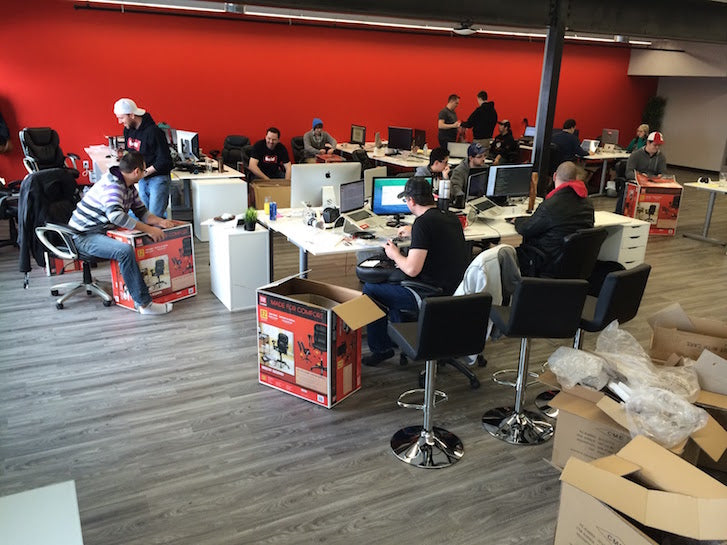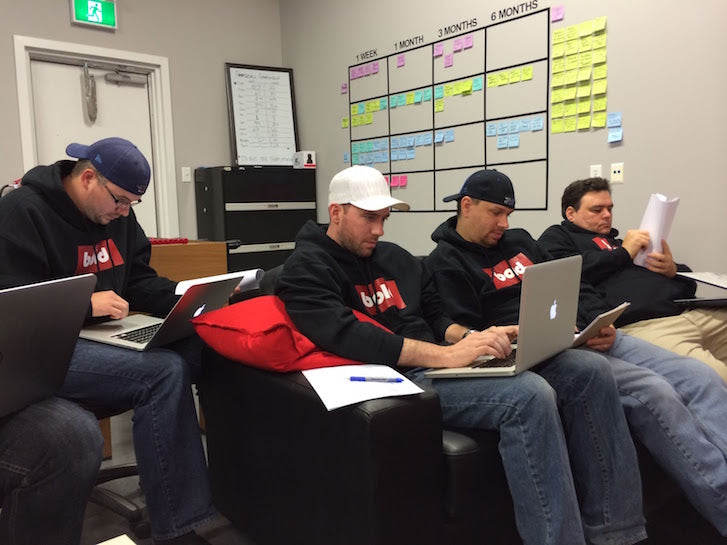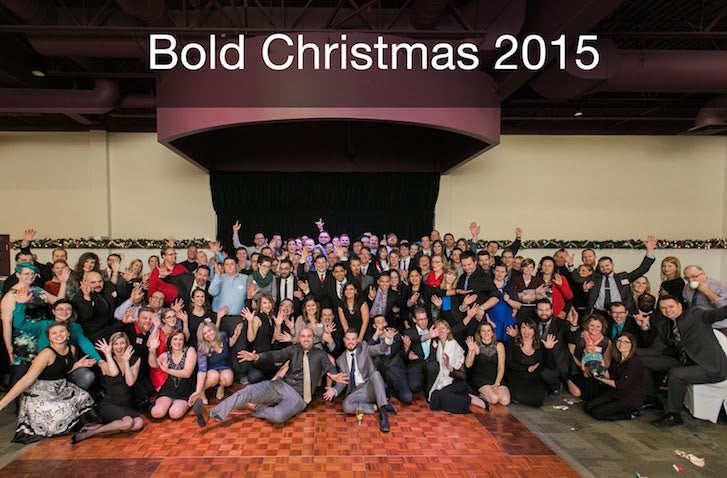When we first met Bold's co-founder Jay Myers in part one of this series, he walked us through the humble beginnings of what has now become a massively successful company.
He then took us through the growing pains of scaling the business and choosing how to diversify their service offerings without disrupting their core services and trying to be all things to all people.
In this final edition, Jay will give us a snapshot of where the company is at right now, and what they’re excited about for the future. Whether you’re just starting up your own business or are well on your way to building a big company, these tips will help you pave the way to your ideal setup.
Bonus: Read to the end for nine apps and tools that the Bold Apps team thinks you should use to increase productivity and improve your workflow.
You might also like: Partner Spotlight: Fifty & Fifty Designs Site for Kickstarter Product
Location, location, location

It would be easy to assume that attracting world-class talent and building a sustainable business would be best done within tried and true markets like San Francisco and New York City. I’ll bet Winnipeg, Manitoba, Canada didn’t pop into mind when thinking of the ideal spot for a tech company. But has their northern location hindered their success? Not so, according to Jay.
He was visiting San Francisco recently, and speaking with a fellow Shopify Partner.
The friend asked, “How have you been able to grow so fast?”
Jay replied, “What do developers in San Francisco make? We can hire four for that price. How much do you pay for rent? We pay a quarter of that.”
Although Bold isn’t offshore, they’re able to compete with companies in more expensive markets — and they’ve even been able to recruit a handful of employees willing to relocate to the Great White North for the opportunity.
“Yes, it’s been a little tougher finding talent in Winnipeg,” Jay said, “but it’s been an absolute blessing to be where we are.”
A video highlighting Bold as an example of a successful Manitoba-based business.
Creating office culture
Everyone who shows up in Bold’s office takes off their shoes. There are couches; free lunches; video games. Espresso machines and an arcade. These perks are often described when talking about the culture at Bold — but Jay insists there’s more to it than that.

“We’ve struggled to define the culture here,” he said. “All the perks are cool, but that’s surface-level culture.”
What really matters, what is truly at the core of the company’s culture, is the level at which employees feel as though they can add value to the business, and to grow professionally.
“That’s culture,” Jay says. “The no shoes and food, that’s just cool stuff that makes it a nice work environment — but culture is what makes our employees thrive and grow. Playing games isn’t culture.”
This philosophy is best exemplified with the company’s Pitch Days, where employees can pitch a crazy business idea. If it gets chosen, they get paid to work on it, and are given $1,000 or 1% of whatever the business idea makes. Some of these crazy ideas have actually panned out — and have made up an entirely new and experimental division of the company. It’s called Bold Labs.
#InnovateOrDie Days at Bold.
You might also like: Partner Spotlight: Squashed Pixel's Award-Winning Site for Rue Marcellin
Bold Labs
Back in part one of this series, Jay mentioned that he will often choose projects based on whether or not they are “fun.” Sounds silly, but everyone will work extra hard on a project they’re enjoying.
One such “fun” decision is Bold Labs. The company takes 20% of their resources, and devotes them to experimental research and development projects.
“The only rule we have about them is that they have nothing to do with ecommerce,” Jay says.
The idea came because the founders and most early employees were all tinkerers. They started their work on Shopify as a hobby in the evenings, and they vowed never to lose their desire to work on exciting projects on the side.
Bold Labs is the home to fun projects including a wireless beacon solution for hospitals and restaurants, so that you can log onto WiFi and see the menu. There’s a project called Inviid, taggable video software that allows you to click on a product and be taken to a shopping cart to purchase it.
A recently launched one that Jay is very excited about is called KickBooster — the first affiliate program available for the crowdfunding website Kickstarter. Previously, Kickstarter didn’t allow affiliates, as you couldn’t add a script to track referrals. Jay’s team figured out a way to "hack" Google Analytics to allow people to share a link to a Kickstarter project, and earn a referral payment when people back it as a result. It's even been picked up by TechCrunch already!

“These projects are all experiments,” Jay says. “We have a lot of failure on these, but that’s the nature of the department. Most will fail — but one might take off.”
Biggest failure
Some Bold Labs ventures never get off the ground, but those aren’t true failures. They’re learning opportunities; investments into an entrepreneurial education.
But what is the biggest failure Bold has faced since the start? It’s tough to talk about, but it’s important.
On the company’s first Black Friday, their servers went down, leaving many merchants with apps that weren’t working.
“That was our darkest day ever,” Jay said. “It was an oversight; we simply didn't expect the increase in traffic that we received. .”
The only thing to be done was to make sure it never happened again. The company invested in an incredibly powerful server setup; they spared no expense. Their setup is similar, or even better, to what Fortune 500 companies rely on.
“Now when our clients go on Shark Tank and ask if our servers will go down from the traffic, we laugh a bit on the inside,” Jay said. “We're so confident in our setup now. Our clients run SuperBowl commercials and it doesn't even tickle them.”
They’ve also shared their lessons learned in an article about how to avoid getting caught with your app down on Black Friday and Cyber Monday.
The pains of success
With their growth has come a number of copycats — those trying to duplicate their apps at a lower price. But one of the things Jay has learned is that he can’t bother being distracted by these wannabes — he needs to remain focused on the loyal customers that know better than to go with a cheaper knockoff.
“It’s been so tempting to try to compete with them, but we have to know what we’re worth and charge what we’re worth,” Jay says. “You have to hold the value. You never win when it’s a price war.”
Although Bold is one of the largest app developers on Shopify, they’ve never looked at total number of users as a very important marker. They actually consider it a vanity metric. What they do consider essential metrics of success are how long their users keep apps installed (churn), how happy they are with them, the percentage of users that have more than one app, and how many take advantage of additional services Bold offers.
Focusing on these types of metrics has been key to helping Bold grow exponentially month after month. Because of this focus, they now get as many new users in a month as they used to get in an entire year.
Looking forward
Bold’s employee headcount has been skyrocketing alongside their app sales and revenues. Today, the team consists of 76 employees — a far cry from the original four founders working out of a basement and interviewing candidates in the local Starbucks. They doubled their company in the first six months of this year. They've signed four leases for new buildings in the past two years, one as recently as May 2015, and are already outgrowing them all.. In fact, I found out that between the time of doing this interview and publishing it, they've acquired a new 26,000 square foot building that they'll be moving into February 1st. This building will handle up to 230-240 employees. Hopefully that will hold them for a bit.

Every department is ramping up, and Jay’s conservative estimate is that they will reach 230 employees within the next 24-36 months.
The long-term goal is to open a technology park in Winnipeg, and open up office space to other startups in the city.
“There was so much stuff we didn’t know when we started, and we had to figure it out on our own,” Jay says. “Bold Technology Park would allow us to help other startups get through that phase. We would share a cafeteria, share a board room, and collaborate on gained knowledge such as server infrastructure for example.”
It’s a way to give back to the tech community, and to come full circle from their scrappy beginnings.
Jay has said that he knew the money was in making the tools, and that’s why they focused their business on building apps for Shopify’s platform. But it appears as though the money is also in the people — those who are willing to seize opportunities in uncharted waters; those willing to make the leap into the unknown; and those willing to stick along for the wild ride that ensues. Check out this timeline of the company’s milestones and growth.
A recap of how it all began.
To avoid getting too mushy, let’s go over some tools Jay’s team uses on a daily basis and would recommend to improve your productivity and workflow.
Recommended Tools
- Slack: For internal communication. Initially, they used Google Hangouts, but Jay said it became too distracting having multiple text boxes popping up at the bottom of their inbox screens.
- InVision: For app mockups and design iterations.
- ZenDesk: For support and ticketing.
- Intercom: For event-triggered customer communication. For example, instead of sending off a mass email to different time zones, the email is triggered upon login so the user receives it when they’re active.
- New Relic: To measure many different areas of app performance.
- JIRA Software: For agile development any time they have a feature to add to an app, or a bug to fix.
- Trello: Used as an idea board. If it’s a good idea, it becomes a JIRA task.
- GitLab: For coding, testing, and deploying.
- CrowdFire: For social media engagement tracking.
What tips do you have for others attempting a freelance career? What was it like when you finally quit your day job? And is there such a thing as too much growth? Share your thoughts in the comments below — we’d love to learn from you.
You might also like: Partner Spotlight: ReCharge Launches 5-Hour ENERGY Subscriptions

